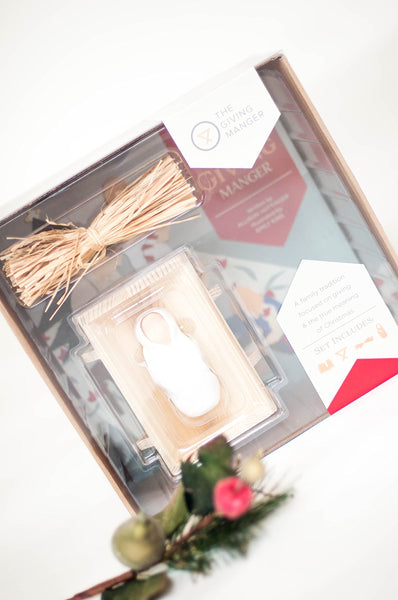If there were an entrepreneurial gene, there’s no doubt that sisters Lisa Kalberer and Allison Hottinger have it.
Their first venture together? Baby slings. “We didn’t really know what we were doing,” Kalberer says. “We thought it was a hobby business.”
Those who know them wouldn’t be surprised. The women come from an entire family of entrepreneurs, including their father. “That’s really where I think it all came from,” Kalberer says. “Maybe we always had that desire in the back of our minds to do it.”
The baby sling business was successful, but their most brag-worthy retail venture is The Giving Manger. They’re in their third year of business, and it’s a retail brand with a loyal customer following — and just one product. On top of that, this product is only in demand once a year.
So, how do Kalberer and Hottinger find success in seasonal sales? They share how they got started, how they’ve grown, and how you can use a combination of in-person and ecommerce selling to make sales year round.
Kickstarter Beginnings
The Giving Manger began out of a genuine love for the holiday season. “We love Christmas, we love to do traditions with our kids,” says Kalberer.
Hottinger started a tradition in her home — assembling a small manger together as a family, inspired by an old Eastern European tradition.
After doing it in her home one year, tons of people asked Hottinger about it. “Wow, this might be something people would like,” she thought. She told Kalberer, and the two hit the ground running.
“[Hottinger] started writing the book [that accompanies the manger], I started designing the manger, and we decided to do a Kickstarter campaign,” Kalberer says. “We were completely funded in two days.”
Their successful 2015 Kickstarter campaign proved there was a market for this kind of seasonal product. Each kit comes complete with a wooden manger, a bundle of straw, a tiny baby Jesus, and the accompanying book. The pair aim for the kit to spark a new Christmas tradition.
Six months later, their samples came to life, they created their marketing collateral, and the women were setting down the building blocks for a thriving retail business.
The Power of a Brand Story
 “We didn’t do any paid promotions [for the Kickstarter],” Kalberer says. “We did it organically.”
“We didn’t do any paid promotions [for the Kickstarter],” Kalberer says. “We did it organically.”
A completely funded Kickstarter in just two days, and zero paid promotion behind it — what’s their secret? An authentic brand story.
We really love giving people a tradition that’s not just about receiving,” Kalberer says.
Many holiday traditions revolve around good behavior rewarded with presents. Kalberer and Hottinger wanted to create a tradition in their own families that means more than that — and then they wanted to share it so other families can make meaningful memories, too.
“Some really influential people in the Christian market reached out to us just from our Kickstarter campaign,” she says. They loved the idea, and word spread quickly. "Everyone really rallied for us, and it’s pretty amazing."
Consumers all over the country heard about The Giving Manger, but it was all organic growth — not paid.
“It’s so fun to give people something that kind of changes Christmas a little bit for them,” Kalberer says. It’s a constant topic of conversation during the holiday season in her own household, too.
Expanding the Business
 “Our first season, we sold out in November, and then were able to deliver a [small order] in December,” Kalberer says. “Last year, we sold out the first week in December.”
“Our first season, we sold out in November, and then were able to deliver a [small order] in December,” Kalberer says. “Last year, we sold out the first week in December.”
Despite The Giving Manger’s organic success, Kalberer and Hottinger worked hard to actively grow the business themselves. They focus on listening to their customers and allowing those insights to inform their business decisions.
When customers asked where they could find the mangers locally, Kalberer and Hottinger knew they had to expand to brick-and-mortar retailers. They made the jump this year, and have been “overwhelmed by the response.”
Being in stores has not only allowed The Giving Manger to expand and reach new markets, it’s also provided another way to gather insights. “[The retailers] are great with giving us feedback, because they talk to customers all day,” Kalberer says.
Though many stores expressed interest in them, the sisters also seek out ideal opportunities. “We have specific retailers that we think would be good partnerships,” Kalberer says. They hired a rep group to help them increase their reach and get their product in more stores.
The two have also gone to industry shows to spread the word about their mission. They started small — “we were a little nervous” — and went to their first market in Dallas. “People loved it, and we were so pleased with the response,” Kalberer says.
But that’s not their only idea. “Most companies have a million SKUs — we’ve got one,” Kalberer says. Now, they’re thinking about introducing new product lines to “expand on the tradition” and what they’ve already built.
The Giving Manger has expanded as a team, too. They hired a full-time employee to handle a number of tasks, including customer service, research, and other time-consuming jobs.
“We try to outsource anything that’s really time-consuming, so we can focus on operating the business,” Kalberer says.
FURTHER READING: Want to delegate more of your retail tasks? Read our guide on outsourcing in retail.
“I think you have to do that even if you hate spending the money, especially when you’re starting out,” she says. “I think you can’t run your business effectively unless you outsource all those little things.”
How They Manage Seasonal Selling
 Managing such rapid growth isn’t easy for any retailer. But Kalberer and Hottinger have grown their business organically, and avoided biting off more than they can chew.
Managing such rapid growth isn’t easy for any retailer. But Kalberer and Hottinger have grown their business organically, and avoided biting off more than they can chew.
We’re smart and strategic about our growth,” Kalberer says. “[The Giving Manger] grows with the amount of effort we put into the marketing, and what we see with word-of-mouth.
For them, once the product runs out, that’s it. Customers have to wait until next year if they didn’t purchase one in time.
“Obviously, we don’t want to not have products, because then we’re not making money,” says Kalberer. Even though they plan orders based on a lot of insights, they still sell out. But that idea of scarcity works to The Giving Manger’s benefit: You better buy them when you see them, or else risk missing out.
This seasonal selling model works to their benefit, but it also presents unique challenges. The two put in 80-hour weeks during their busy season. Surprisingly, Kalberer says that the busy season is January through June. “It’s all wholesale. That’s where we put all our time and focus,” she says. “Once we hit August through December, it’s all retail and taking care of our wholesalers and fulfilling product for them.”
In addition to taking orders directly through their site, the duo wholesale their kits to dozens of boutiques, pharmacies, and gift shops across the U.S.
That’s a lot of work for two busy moms — Hottinger has five children, and Kalberer has one, and also battles multiple sclerosis. That’s why it’s so important for them to find balance.
“We both have to take a little time for ourselves and jump in for one another,” Kalberer says. “
Their seasonal selling model also presents operational and projection obstacles. “We have to estimate for the year how many [products we] want, so it’s a guess every year,” Kalberer says. They’ve guessed well so far, and they’ve tripled production this year.
This trajectory has also worked in the retailers’ favor. “We don’t have to take out a giant loan and have product in a warehouse,” Kalberer says. “It would cost a lot to store. And we’ve created our own demand by growing well.”
Lessons Learned
Growth
“[We] do one thing at a time so we can do it well,” Kalberer says. Let your customers and your successes guide your growth.
If you sell in stores, use them as another arm to your research. “Call your stores, talk to your stores. Really be friends with your retailers,” Kalberer says. “They will give you so much information, it’s insane.”
Kickstarter
“Kickstarter is the perfect test market,” Kalberer says. “You can see if people are really interested in your product.” The Giving Manger found the most success by simply sharing their story, instead of asking for funds. That way, people got behind the brand, and the Kickstarter grew on its own.
If you’re thinking of running a Kickstarter campaign, focus not only on your product, but the story behind it. Here, learn how you can nail your brand story — and then use it as part of your Kickstarter campaign.
Manufacturing
Manufacturing is a common challenge for retailers, and that’s no different for The Giving Manger. Even though Kalberer and Hottinger have a cousin who’s a broker — who helped them find a great manufacturer — the pair have run into their fair share of challenges.
“We fought and worked really hard with our manufacturer, and we to a bunch of others and pushed [for the best deal],” Kalberer says.
They settled on a manufacturer, with whom they’ve been working for the past three years. “It’s always overwhelming,” Kalberer says. This year, they printed the packaging backward.
But, Kalberer and Hottinger have learned how to create a good relationship with their manufacturer. “If you stay with the same factory, they see the growth potential,” Kalberer says. “I think they can see how quickly our business is scaling, and I think using that leverage was helpful.”
Packaging
 On the note of manufacturing, Kalberer and Hottinger learned about the importance of packaging along the way, too. “We designed our packaging very specifically so it was self-explanatory,” Kalberer says. They had to accommodate for the fact that consumers might need an explanation of what this product is, and how to use it, without requiring the presence of representatives of The Giving Manger brand.
On the note of manufacturing, Kalberer and Hottinger learned about the importance of packaging along the way, too. “We designed our packaging very specifically so it was self-explanatory,” Kalberer says. They had to accommodate for the fact that consumers might need an explanation of what this product is, and how to use it, without requiring the presence of representatives of The Giving Manger brand.
Luckily, they caught the backwards-printed packaging early on. “We’re constantly requesting [samples],” Kalberer says. “You have to stay on top of it.”
They’ve also been able to make changes to the packaging to help reduce costs. Working with their manufacturer to shrink both the size of the pieces of the product and the box itself has helped them save money in their business.
Enjoy Time Off
“The No. 1 thing that we do during the summer is hang out with our kids, and it’s fantastic,” Kalberer says. “We enjoy every minute of it.”
Once their 80-hour weeks are no longer necessary, Kalberer and Hottinger reap the benefits of their business. “We take the summer off, we enjoy our families, we travel, and we have fun,” she says. “Then we come back and hit the ground running.”
“That’s the beauty of a seasonal business.”
